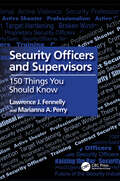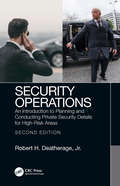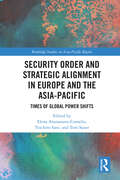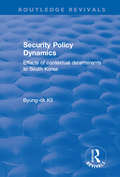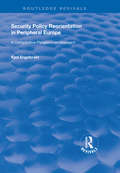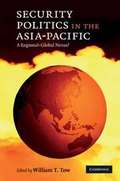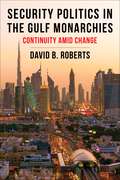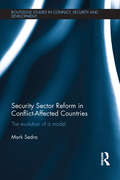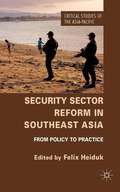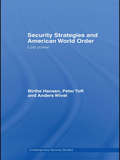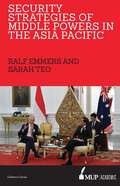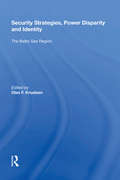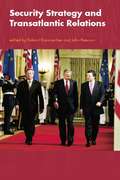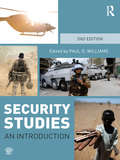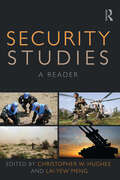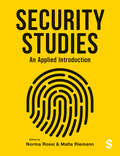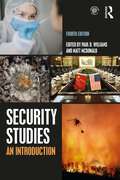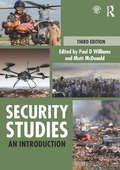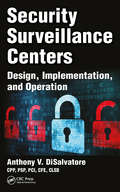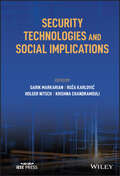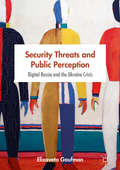- Table View
- List View
Security Officers and Supervisors: 150 Things You Should Know
by Lawrence J. Fennelly Marianna A. PerrySecurity Officers and Supervisors: 150 Things You Should Know presents an array of relevant topics, including addressing “Tips of the Trade” in how to manage a team of professionals and serve as an effective supervisor. This includes both keeping management informed of decisions, aligning policy, procedure, and training with business objectives, and hiring and managing a team of professionals to maintain continuity of operations and a safe, secure environment. There are many factors involved in managing a department and workforce and the book uses a handy-reference format to present the salient information, both concrete knowledge as well as the softer skills, required for managers to motivate individuals and lead teams to pull in the same direction.Short, easy-to-read chapters include lists of relevant definitions, some do’s and don’ts, best practices, emerging trends, and well as example case studies based upon the authors’ professional experience. The primary goal is to provide a foundation for readers to identify, comprehend, and apply management concepts and security principles in their own environments so that readers will be readily prepared to troubleshoot problems and overcome challenges.Building and leading a trusted team that can set and achieve clearly outlined objectives begins with leadership. Security Officers and Supervisors: 150 Things You Should Know outlines those principles and traits required for professionals to succeed when promoted (though, more often than not, thrust!) into a security supervisory role.
Security Operations: An Introduction to Planning and Conducting Private Security Details for High-Risk Areas
by Robert H. Deatherage, Jr.Security Operations: An Introduction to Planning and Conducting Private Security Details for High-Risk Areas, Second Edition was written for one primary purpose: to keep people alive by introducing them to private security detail tactics and techniques. The book provides an understanding of the basic concepts and rules that need to be followed in protective services, including what comprises good security practice. This second edition is fully updated to include new case scenarios, threat vectors, and new ambush ploys and attack tactics used by opportunistic predators and seasoned threat actors with ever-advanced, sophisticated schemes. Security has always been a necessity for conducting business operations in both low- and high-risk situations, regardless of the threat level in the operating environment. Overseas, those with new ideas or businesses can frequently be targets for both political and criminal threat agents intent on doing harm. Even in the United States, people become targets because of positions held, publicity, politics, economics, or other issues that cause unwanted attention to a person, their family, or business operations. Security Operations, Second Edition provides an introduction to what duties a security detail should perform and how to effectively carry out those duties. The book can be used by a person traveling with a single bodyguard or someone being moved by a full security detail. FEATURES • Identifies what can pose a threat, how to recognize threats, and where threats are most likely to be encountered • Presents individuals and companies with the security and preparedness tools to protect themselves when operating in various environments, especially in high-risk regions • Provides an understanding of operational security when in transit: to vary route selection and keep destinations and movement plans out of the public view • Outlines the tools and techniques needed for people to become security conscious and situationally aware for their own safety and the safety of those close to them An equal help to those just entering the protection business or people and companies that are considering hiring a security detail, Security Operations is a thorough, detailed, and responsible approach to this serious and often high-risk field. Robert H. Deatherage Jr. is a veteran Special Forces Soldier and private security consultant with thirty years’ experience in military and private security operations. His various writings on security topics cover security operations, threat assessment, risk management, client relations, surveillance detection, counter surveillance operations, foot and vehicle movements, and building security—blending solid operational theory with practical field experience.
Security Order and Strategic Alignment in Europe and the Asia-Pacific: Times of Global Power Shifts (Routledge Studies on the Asia-Pacific Region)
by Yoichiro Sato Tom Sauer Elena Atanassova-CornelisElena Atanassova-Cornelis, Yoichiro Sato, Tom Sauer, and their contributors examine the implications of the shifts in power for the regional security order, as the longterm relative decline of the US standing in the global hierarchy of power is more pronounced than ever due to the challenges it faces from the rising China in Asia and the reviving Russia in Europe.The world is in disarray, and the balance of power is shifting, which results in enhanced tensions and wars, including on the territory of Europe. The complexity of the international order that prevails today possibly misleads us toward viewing everything in terms of a bipolar competition, as predicted by systemic-level realism. While membership of the multilateral NATO Alliance expands in Europe in light of the ongoing Russian invasion of Ukraine, China’s assertive behavior in Asia has produced numerous strategic alignments that are short of a formal alliance involving Asian states, the US, and European countries. ‘Hedging’ strategies are commonly found in Asian states’ approaches to security, working against the bifurcation of powers. Contrarily, European entries into alignments in the ‘Indo-Pacific’ have demonstrated the inseparability of security in Asia from security in Europe through the shared thread of ‘engaging the US’. Whether China defines its challenge against the US in regional or global terms also has differing implications for the evolution of the international system. This book, with contributions by Asian, European, and North American experts, provides an overview of the two regions’ differing alignment paths in comparative and inter-regional perspectives.The book is a valuable resource for academics, researchers, practitioners, and policy analysts interested in European and Asia-Pacific security, as well as international and regional security issues.
Security Policy Dynamics: Effects of Contextual Determinants to South Korea (Routledge Revivals)
by Byung-ok KilThis title was first published in 2001: Byung-ok Kil's thorough analysis deals with both the broad area of public policy and the specific topic of national security policy change in Korea. Using an historical comparative approach, he tests the relative importance of international and domestic developments as determinants of security policy change. Drawing extensively on carefully selected sources of quantitative and qualitative data including original documents and interviews, this engaging text is of theoretical, methodological and applied policy relevance to the academic community and of substantive interest to a broader audience of governmental officials in national security and related policy areas.
Security Policy Reorientation in Peripheral Europe: A Comparative-Perspectivist Approach
by Kjell EngelbrektThis title was first published in 2002. This rich comparative analysis looks at security policy reorientation in four European states located at the periphery of the European continent. During the post-Cold War period, Greece, Bulgaria, Sweden and Finland conducted a security policy that was heavily influenced by their close proximity to the iron curtain . Probing this transition during a decisive phase of the post-Cold War reconstitution of the wider European security order, the author analyzes national security policy making from the standpoints of three international relations traditions - realism, institutionalism and political anthropology. This engaging work is invaluable for students, scholars and policy analysts working in the field of international relations and European politics.
Security Politics in the Asia-Pacific: A Regional-Global Nexus?
by William T. TowAsia is experiencing major changes in its security relations. This book brings together respected experts to assess both the theoretical and empirical dimensions of the Asian security debate. Building on the latest research on Asia's regional security politics, it focuses on the 'regional-global nexus' as a way to understand the dynamics of Asian security politics and its intersection with global security. Contributors to the volume offer diverse but complementary perspectives on which issues and factors are most important in explaining how security politics in Asia can be interpreted at both the regional and global levels of analysis. Issues addressed include power balancing and alliances, governance and democracy, maritime and energy security, the relationship between economics and security, 'human security', terrorism, nuclear non-proliferation, climate change and pandemics. This work will serve as a standard reference on the evolution of key issues in Asian security.
Security Politics in the Gulf Monarchies: Continuity Amid Change (Columbia Studies in Middle East Politics)
by David B. RobertsThe Gulf monarchies—Saudi Arabia, Kuwait, Bahrain, Qatar, Oman, and the United Arab Emirates—play crucial roles in world markets and politics. Their economies, which have traditionally been driven by oil revenues, have simultaneously propelled transformative change and preserved the traditional order. Fossil fuel wealth has underwritten an implicit social contract characterized by generous welfare states, ruler-centric politics, and a heavy state presence in the economy, facilitating stability during tumultuous times. However, as the transition toward renewable energy looms, will the Gulf monarchies be able to adapt?David B. Roberts offers a definitive guide to continuity and change in the Gulf region. He explores the forces challenging and bolstering the status quo across the political, social, economic, military, and environmental dimensions of security. Roberts examines the six monarchies individually and holistically, considering their recent histories and contemporary concerns. Beneath wide-ranging changes affecting these countries, he pinpoints key dynamics and structures that have persisted over the long term. The book examines key topics such as generational change in leadership, migrant workers, female labor force participation, U.S. military influence, and the multifaceted threat of climate change. Roberts scrutinizes how a move away from the oil-centered economic model could reverberate across the social spectrum, with profound implications for security. Suitable for a range of courses and offering important new insights for experts, this book is an accessible and up-to-date overview of the politics of a key world region.
Security Relations between China and the European Union
by Kirchner Emil J. Thomas Christiansen Han DorussenOver the past decade, the EU and China have expanded their relations beyond a focus on economic and trade issues to the sphere of security. Taking a broad definition of security, a multidisciplinary approach, and a comparative perspective (including scholars from both Europe and China), this book provides an in-depth analysis of the extent to which the EU and China not only express similar threat concerns, or make declarations about joint responses, but also adopt concrete measures in the pursuance of security cooperation. In particular, the book seeks to explore a range of key themes in the field of EU-China security cooperation such as nuclear proliferation, international terrorist threats and cyber attacks. Besides providing an overview of the areas where security cooperation exists and where it does not, it also highlights the aspects of convergence and divergence and the reasons for their occurrence.
Security Sector Reconstruction and Reform in Peace Support Operations
by Michael Brzoska and David LawThis volume provides a framework for analyzing security sector reform under international tutelage.Following violent conflict and military interventions, international organizations or coalitions of countries increasingly engage in post-conflict reconstruction. Part of the international post-conflict agenda is thereconstruction orreform of th
Security Sector Reform in Conflict-Affected Countries: The Evolution of a Model (Routledge Studies in Conflict, Security and Development)
by Mark SedraThis book examines the evolution, impact, and future prospects of the Security Sector Reform (SSR) model in conflict-affected countries in the context of the wider debate over the liberal peace project. Since its emergence as a concept in the late 1990s, SSR has represented a paradigm shift in security assistance, from the realist, regime-centric, train-and-equip approach of the Cold War to a new liberal, holistic and people-centred model. The rapid rise of this model, however, belied its rather meagre impact on the ground. This book critically examines the concept and its record of achievement over the past two decades, putting it into the broader context of peace-building and state-building theory and practice. It focuses attention on the most common, celebrated and complex setting for SSR, conflict-affected environments, and comparatively examines the application and impacts of donor-supported SSR programing in a series of conflict-affected countries over the past two decades, including Afghanistan, Sierra Leone, the Democratic Republic of Congo, East Timor and Bosnia-Herzegovina. The broader aim of the book is to better understand how the contemporary SSR model has coalesced over the past two decades and become mainstreamed in international development and security policy and practice. This provides a solid foundation to investigate the reasons for the poor performance of the model and to assess its prospects for the future. This book will be of much interest to students of international security, peacebuilding, statebuilding, development studies and IR in general.
Security Sector Reform in Southeast Asia
by Felix HeidukSuccessful reform of the security sector has been regarded as pivotal for a successful transition from authoritarianism to democracy by Western donors. A global cast of contributors examines SSR in a variety of policy fields in Southeast Asia, paying specific attention to the adaption of 'Western' reform concepts by local actors.
Security Strategies and American World Order: Lost Power (Contemporary Security Studies)
by Anders Wivel Birthe Hansen Peter ToftThis book analyses security strategies in the American world order, systematically comparing Russian, Middle Eastern and European policies. The main finding is that the loss of relative power has decisive importance for the security strategies of states, but that particular strategies can only be explained when relative power is combined with ideology and the probability of military conflict. Research on the unipolar world order has focused largely on the general dynamics of the system and the actions of the American unipole. By contrast, this book focuses on states that lost out relatively as a consequence of unipolarity, and seeks to explain how this loss has affected their security strategies. Thus, in essence, the book tells ‘the other side of the story’ about the contemporary world order. In addition, it makes an important theoretical contribution by systematically coupling relative ideology and relative security with relative power and exploring their explanatory value. This book will be of great interest to students of international relations, security studies and foreign policy.
Security Strategies in the Asia-Pacific
by Andrew T H TanThis book argues that, given the existence of a discrete Malay archipelago security complex, it is a fallacy for the United States to approach this region primarily through the prism of global counter-terrorism
Security Strategies of Middle Powers in the Asia Pacific
by Ralf Emmers Sarah TeoSecurity Strategies of Middle Powers in the Asia Pacific examines what drives the different regional security strategies of four middle powers in the Asia Pacific: Australia, Indonesia, South Korea and Malaysia. Drawing on the extant middle power literature, the authors argue that the regional security strategies of middle powers could take two forms, namely, functional or normative. A functional strategy means that the middle power targets its resources to address a specific problem that it has a high level of interest in, while a normative strategy refers to a focus on promoting general behavioural standards and confidence building at the multilateral level. This book argues that whether a middle power ultimately employs a more functional or normative regional security strategy depends on its resource availability and strategic environment.
Security Strategies, Power Disparity and Identity: The Baltic Sea Region
by Olav F. KnudsenWhat is power and how is it effective? This volume responds to these questions in terms of regional international relations with a particular focus on the Baltic Sea region, an area still charged with a residue of Cold War conflict and power disparity, in a setting of new cooperative ventures. Each contributor examines the region from a different angle and discusses how its actors coped with the new situation facing them after 1991. The volume looks at how governments have defined their new circumstances, how they have dealt with the opportunity to shift to a new mode of coexistence and collaboration, and how they have tackled the challenge of peacefully converting their region to a security community. The book breaks with tradition by adopting a new, thematic approach based on regional issues and functions rather than a country-by-country discourse. It will be of critical value to readers interested in security studies and European politics.
Security Strategy and Transatlantic Relations
by John Peterson Roland DannreutherIn this much-needed study of current strategic thinking on both sides of the Atlantic, a diverse collection of leading European and American analysts are assembled to tackle key questions that remain unanswered in the existing literature: how much do new security strategies signal convergence or divergence in US and EU foreign and security policy doctrine? what tangible political and policy impacts can be attributed to new security strategies? what are the implications for US and EU policies towards specific regions? what are the prospects for collective transatlantic action? The legacy of 9/11 is scrutinized against the backdrop of the strategic thinking that preceded it. In the 1990s, the US struggled to develop a new doctrine for American foreign policy, seeking at various times to promote a ‘New World Order’ or ‘democratic enlargement’. For its part, the EU had tried to underpin its new Common Foreign and Security Policy with a coherent set of ‘European values’ – multilateralism, human rights, environmental protection, and poverty reduction – that were best defended via collective European action. Key continuities and changes in these transatlantic efforts since 9/11 are clearly identified and closely examined.
Security Studies
by Paul D. WilliamsSecurity Studies is the most comprehensive textbook available on security studies. Comprehensively revised for the new edition including new chapters on Polarity, Culture, Intelligence, and the Academic and Policy Worlds, it continues to give students a detailed overview of the major theoretical approaches, key themes and most significant issues within security studies. Part 1 explores the main theoretical approaches currently used within the field from realism to international political sociology. Part 2 explains the central concepts underpinning contemporary debates from the security dilemma to terrorism. Part 3 presents an overview of the institutional security architecture currently influencing world politics using international, regional and global levels of analysis. Part 4 examines some of the key contemporary challenges to global security from the arms trade to energy security. Part 5 discusses the future of security. Security Studies provides a valuable teaching tool for undergraduates and MA students by collecting these related strands of the field together into a single coherent textbook. Contributors:Richard J. Aldrich, Deborah D. Avant, Sita Bali, Michael N. Barnett, Alex J. Bellamy, Didier Bigo, Pinar Bilgin, Ken Booth, Barry Buzan, Stuart Croft, Simon Dalby, John S. Duffield, Colin Elman, Louise Fawcett, Lawrence Freedman, James M. Goldgeier, Fen Osler Hampson, William D. Hartung, Michael Jensen, Adam Jones, Danielle Zach Kalbacher, Stuart J. Kaufman, Michael T. Klare, Peter Lawler, Matt McDonald, Colin McInnes, Cornelia Navari, Michael Pugh, Paul R. Pillar, Srinath Raghavan, Paul Rogers, Waheguru Pal Singh Sidhu, Joanna Spear, Caroline Thomas, Thomas G. Weiss, Nicholas J. Wheeler, Sandra Whitworth, Paul D. Williams, Phil Williams and Frank C. Zagare.
Security Studies: A Reader (The\university Of Sheffield/routledge Japanese Studies Ser.)
by Yew Meng Lai Christopher W. HughesThis reader brings together key contributions from many of the leading scholars in the field, offering students an informed overview of the most significant work in security studies. The editors chart the development of the key theoretical and empirical debates in security studies in the Cold War and post-Cold War periods, introducing the ideas of the most influential ‘past masters’ and contemporary thinkers on security in the UK, US and elsewhere. The book is divided into five areas: What is Security? Security Paradigms Security Dimensions and Issues Security Frameworks and Actors The Future of Security. In order to guide students through the issues, the book has a substantial critical introduction exploring the development of security studies, as well as introductory essays that provide an overview of each section, highlighting clearly how the readings fit together. Suggestions for further reading and key questions for discussion are also included. Security Studies is an invaluable resource for all students of security studies and international relations.
Security Studies: An Applied Introduction
by Norma Rossi Malte RiemannSecurity Studies: An Applied Introduction offers a transformative tool to understand, analyse, and engage with the complexities of security in the modern world. This groundbreaking new text redefines the landscape of security studies with the following features: Policy-Relevant: each chapter provides analysis of policy responses to empirical security issues. This practical approach offers a toolkit to assess and contribute to real-world policy discussions. Empirical Application: vividly demonstrating the real-world relevance of Security Studies with online videos from leading security practitioners to show how theory informs practice. Pedagogically Rich: comprehensive online resources and chapters features such as ′security beyond the real′ and hands-on exercises that critically assess real-world security responses and their policy implications that offer ways to apply theoretical concepts in a highly innovative way. Innovative Structure: seamlessly integrating theoretical perspectives with empirical security concerns, this textbook offers a non-compartmentalised approach to theory and practice. Hot Topics: placing contemporary, creative, emerging, and underexplored approaches and empirical topics at the forefront including cyber security, racism, and space security. This is the perfect introduction for undergraduate and postgraduate students studying Security Studies and International or Global Security. Malte Riemann is Assistant Professor in Contemporary Armed Conflict, Leiden University, the Netherlands Norma Rossi is Associate Lecturer in International Relations, University of St Andrews, UK
Security Studies: An Applied Introduction
by Norma Rossi Malte RiemannSecurity Studies: An Applied Introduction offers a transformative tool to understand, analyse, and engage with the complexities of security in the modern world. This groundbreaking new text redefines the landscape of security studies with the following features: Policy-Relevant: each chapter provides analysis of policy responses to empirical security issues. This practical approach offers a toolkit to assess and contribute to real-world policy discussions. Empirical Application: vividly demonstrating the real-world relevance of Security Studies with online videos from leading security practitioners to show how theory informs practice. Pedagogically Rich: comprehensive online resources and chapters features such as ′security beyond the real′ and hands-on exercises that critically assess real-world security responses and their policy implications that offer ways to apply theoretical concepts in a highly innovative way. Innovative Structure: seamlessly integrating theoretical perspectives with empirical security concerns, this textbook offers a non-compartmentalised approach to theory and practice. Hot Topics: placing contemporary, creative, emerging, and underexplored approaches and empirical topics at the forefront including cyber security, racism, and space security. This is the perfect introduction for undergraduate and postgraduate students studying Security Studies and International or Global Security. Malte Riemann is Assistant Professor in Contemporary Armed Conflict, Leiden University, the Netherlands Norma Rossi is Associate Lecturer in International Relations, University of St Andrews, UK
Security Studies: An Introduction
by Paul D. WilliamsSecurity Studies: An Introduction, 4th edition, is the most comprehensive textbook available on the subject, providing students with in-depth coverage of traditional and critical approaches and an essential grounding in the debates, frameworks, and issues of the contemporary security agenda. This new edition has been completely revised and updated, to cover major developments such as COVID-19, the rise of populism, climate change, China and Russia’s place in the world, and the Trump administration. It also includes new chapters on great power rivalry, emerging technologies, and economic threats. Divided into four parts, the text provides students with a detailed, accessible overview of the major theoretical approaches, key themes, and most significant issues within security studies. Part 1 explores the main theoretical approaches from both traditional and critical standpoints Part 2 explains the central concepts underpinning contemporary debates Part 3 presents an overview of the institutional security architecture Part 4 examines some of the key contemporary challenges to global security Collecting these related strands into a single textbook creates a valuable teaching tool and a comprehensive, accessible learning resource for undergraduates and MA students.
Security Studies: An Introduction (Routledge Critical Security Studies)
by Paul D. Williams Matt McDonaldSecurity Studies: An Introduction, 3rd edition, is the most comprehensive textbook available on the subject, providing students with an essential grounding in the debates, frameworks, and issues on the contemporary security agenda. This new edition has been comprehensively revised and updated, with new chapters added on poststructuralism, postcolonialism, securitization, peace and violence, development, women, peace and security, cybersecurity, and outer space. Divided into four parts, the text provides students with a detailed, accessible overview of the major theoretical approaches, key themes, and most significant issues within security studies. Part 1 explores the main theoretical approaches from both traditional and critical standpoints Part 2 explains the central concepts underpinning contemporary debates Part 3 presents an overview of the institutional security architecture Part 4 examines some of the key contemporary challenges to global security Collecting these related strands into a single textbook creates a valuable teaching tool and a comprehensive, accessible learning resource for undergraduates and MA students.
Security Surveillance Centers: Design, Implementation, and Operation
by Anthony V. DiSalvatoreUnlike current books on the market that focus primarily on the technical aspects of surveillance and protection, Security Surveillance Centers: Design, Implementation, and Operation focuses on the operation of a security surveillance center. This text explains in detail the role of security surveillance, as well as the critical aspects of the design, implementation, and operation of security surveillance centers of all sizes. Step-by-step coverage of policy and procedures, as well as the inclusion of industry-specific operational forms, guarantee a practical, user-friendly text for all levels of readers. Intended for any individuals or organizations currently employing security surveillance systems, this book is an asset for all users, from trainees to supervisors, seeking to create a more secure environment for themselves and for others.
Security Technologies and Social Implications
by Garik Markarian Ru A Karlovi Holger Nitsch Krishna ChandramouliB>SECURITY TECHNOLOGIES AND SOCIAL IMPLICATIONS Explains how the latest technologies can advance policing and security, identify threats, and defend citizens from crime and terrorism Security Technologies and Social Implications focuses on the development and application of new technologies that police and homeland security officers can leverage as a tool for both predictive and intelligence-led investigations. The book recommends the best practices for incorporation of these technologies into day-to-day activities by law enforcement agencies and counter-terrorism units. Practically, it addresses legal, technological, and organizational challenges (e.g. resource limitation and privacy concerns) combined with challenges related to the adoption of innovative technologies. In contrast to classic tools, modern policing and security requires the development and implementation of new technologies using AI, machine learning, social media tracking, drones, robots, GIS, computer vision, and more. As crime (and cybercrime in particular) becomes more and more sophisticated, security requires a complex mix of social measures, including prevention, detection, investigation, and prosecution. Key topics related to these developments and their implementations covered in Security Technologies and Social Implications include: New security technologies and how these technologies can be implemented in practice, plus associated social, ethical or policy issues Expertise and commentary from individuals developing and testing new technologies and individuals using the technologies within their everyday roles The latest advancements in commercial and professional law enforcement technologies and platforms Commentary on how technologies can advance humanity by making policing and security more efficient and keeping citizens safe Security Technologies and Social Implications serves as a comprehensive resource for defense personnel and law enforcement staff, practical security engineers, and trainee staff in security and police colleges to understand the latest security technologies, with a critical look at their uses and limitations regarding potential ethical, regulatory, or legal issues.
Security Threats and Public Perception
by Elizaveta GaufmanCountless attempts at analyzing Russia's actions focus on Putin to understand Russia's military imbroglio in Ukraine, hostility towards America, and disdain of 'Gayropa'. This book invites its readers to look beyond the man and delve into the online lives of millions of Russians. It asks not the question of what the threats are to Russia's security, but what they are perceived to be by digital Russia. The author examines how enemy images are manufactured, threats magnified, stereotypes revived, memories implanted and fears harnessed. It looks at the legacy of the Soviet Union in shaping discussions ranging from the Ukraine crisis to the Pussy Riots trial, and explores the complex inter-relation between enemy images at the governmental level and their articulation by the general public. By drawing on the fields of international relations, memory studies, visual studies, and big data, this book addresses the question of why securitization succeeds - and why it fails. "Security theory meets the visual turn and goes to Russia, where old tsarist and Soviet tropes are flooding the internet in support of Putin's neo-tsarism. A magical mystery tour that comes recommended. Iver B. Neumann, author of "Russia and the Idea of Europe" "The novelty of her approach is in going beyond the traditional top down perspective and capturing the receptivity and contribution of various social groups to securitized discourses. " Andrei P. Tsygankov, author of "Russia's Foreign Policy: Change and Continuity in National Identity". "When do scary proclamations of security threats attract an audience? When does securitization work? 'Security Threats and Public Perception' combines in-depth analysis of the Ukraine Crisis in the Russian digital media with discourse theory to make an innovative argument about how and when people believe that they are insecure. A must read!" Laura Sjoberg, Assistant Professor of Political Science, University of Florida, USA
